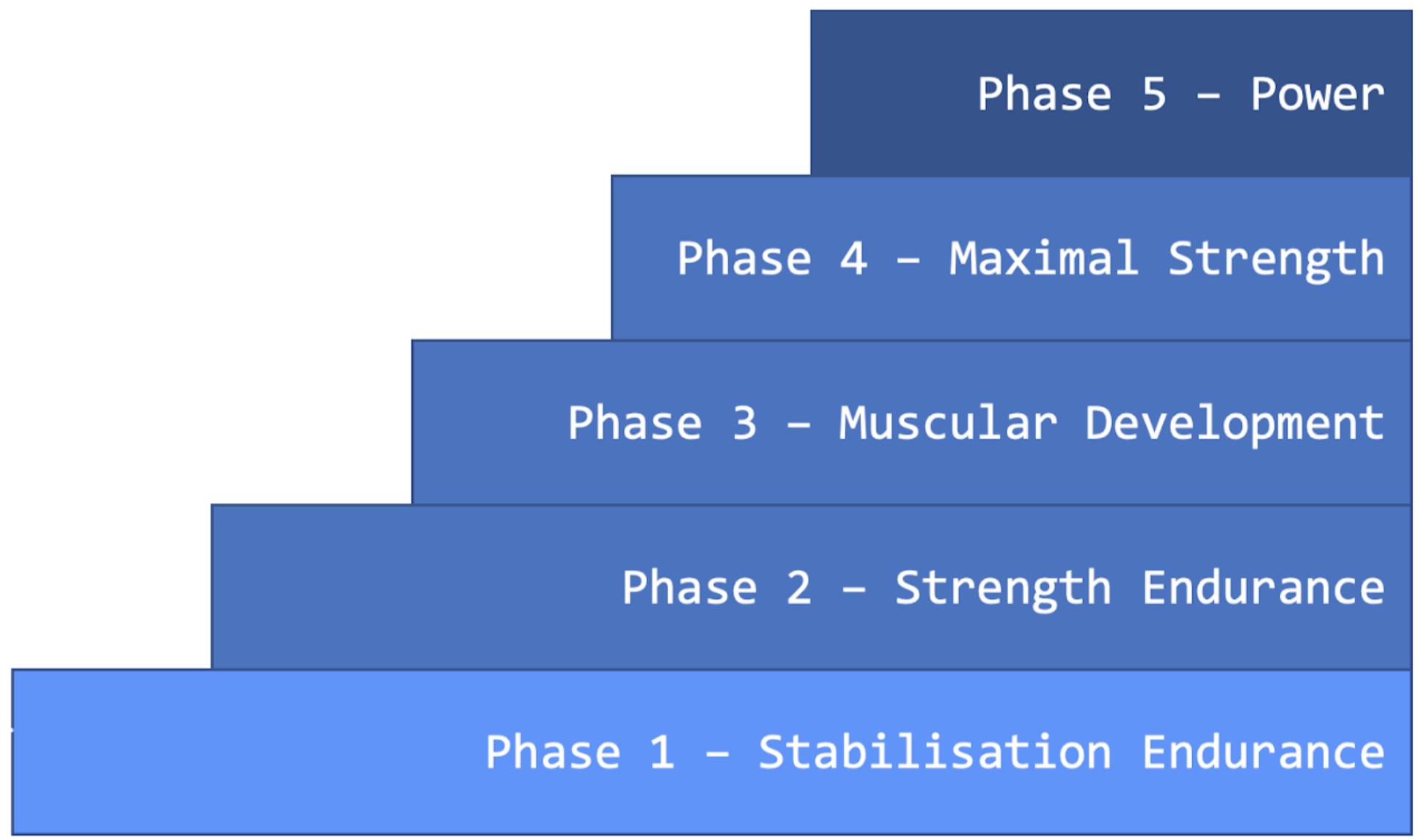Hierarchy of strength and Conditioning Progressions
Strength and conditioning can be a confusing subject. Was it high-reps and light weight I was supposed to be doing today or was it the other way around? There are countless models out there to progress strength and conditioning workouts, in this blog coach Jon explains how to implement these into a triathlon training program.
There are various strength and conditioning models with altered repetition, rest intervals and weight ranges. They may have different names, but all generally follow similar paths; start with high repetitions and light weights and progress to heavier weights with fewer repetitions. For this blog, I will reference the well-founded model used by many Personal Trainers around the world - the Optimum Performance Model produced by NASM (National Academy of Sports Medicine).
As you can see their model lays out a hierarchy in a step formation. As an athlete progresses through the stages the emphasis changes. Generally, everyone should start at the bottom with phase 1 and work their way up, however, not every phase is for every athlete. More on this later. Athletes should spend 4-6 weeks in each phase before moving on to the next phase to encourage adaptation to different stimuli, rather than stagnating by continually repeating the same kind of exercises.
%age of 1 rep max
Before we move on to the strength training phases we need to quickly cover weight ranges - the NASM model uses a percentage of your 1 repetition max. Rather than risking injury by completing a challenging ‘1-rep max’ testing session, it is more sensible to find your ‘5-rep max’. You can repeat this for several exercises to give you an idea of what weight range you should be working within each phase. You can then use an online calculator to calculate your 1 rep max from your 5 rep max result. Like other fitness tests, it is important to re-test regularly to monitor progress and check you are lifting the correct weight. For some athletes, using a 1 rep-max percentage can be confusing and time-consuming, therefore simply going off a light to heavy RPE type scale may be more straightforward.
Let’s take a look at the individual phases:
PHASE 1: STABILISATION ENDURANCE TRAINING
(2-3 sets of 12-20 repetitions at low weight)
Generally, we start with low weights and high repetitions - NASM refers to this as ‘Stabilisation Endurance’ some call this Anatomical Adaptation. It is the foundation phase where we prepare our bodies for the heavier lifts to come. The key principle of this phase is the quality of the movement. The tempo of the movement should be slow and controlled targeting correct form and technique. The exercises in this phase are not progressed by adding weight but by increasing the proprioceptive load. We want to improve neuromuscular efficiency by challenging balance, stabilisation and muscular coordination. We do this by using unstable environments, which means, wobble cushions, wobble boards, single leg work and challenging balance exercises. Working in unstable environments forces the body to recruit more muscles to stabilise itself.
Skipping this important foundation stage, especially if you are new to strength training, can leave you at risk of injury if you go straight for the heavy weights. Even if you are highly experienced with strength work, this foundation stage will be a challenging phase if the exercises are completed correctly - just because the weights are low, it doesn’t mean it will be easy. This phase is so important that it is often sensible to loop back around and revisit it often.
Example exercises:
PHASE 2: STRENGTH ENDURANCE TRAINING
(2-4 sets of 8-12 repetitions at moderate weight 70-80% 1RM)
This phase of the NASM model follows on from stabilisation endurance by using a super-set format where a traditional strength exercise is followed immediately by a stabilisation phase exercise targeting the same muscle group. For example, a moderately heavy squat of 8-12 repetitions would be followed immediately by a single leg balance board squat. This method of training acts as an introduction to heavier lifting whilst still improving neuromuscular efficiency.
Example exercises:
Bench-Press (moderate weight) straight into swiss ball press up (bodyweight)
Bulgarian squat (moderate weight) straight into step-up to balance (light weight)
Most athletes tend to remain in this 8-12 repetition range. Barriers to progressing up the strength training hierarchy are normally, lack of access to a proper gym, lack of time, or the fear of ‘bulking up’ if they lift heavy weights. However, spending too much time in these first two phases can lead to stagnation and burnout. Piling on more ‘muscular endurance’ load (high repetitions at low weight) on top of an endurance training programme (high repetitions at low force) is just adding more of the same. The goal of the next phases in the hierarchy is to stimulate strength improvements, not to trigger the type of metabolic conditioning effects you’re already getting from your swim bike and run workouts.
PHASE 3 MUSCULAR DEVELOPMENT
(3-5 sets of 6-12 repetitions at heavy weights 75-85% 1RM)
The next phase on the NASM hierarchy is Muscular Development or Hypertrophy. Phase 3 is all about building and developing maximal muscle growth. This phase focuses on higher volumes of work with an increased number of sets on each exercise at moderate-to-high load and with minimal rest periods between sets.
Example exercises:
Traditional strength training multi-joint exercises - Front squat, Deadlift, Bench press, Military Row etc.
This is the strength phase that endurance athletes are generally advised to skip as this is the kind of weight training that has the potential to ‘bulk you up' if you spend enough time doing it and have enough excess calories in your diet to fuel those growing muscles. Most endurance athletes stand to make the biggest gains by prioritising phases 4 and 5; Maximal Strength and Power.
PHASE 4: MAXIMAL STRENGTH TRAINING
(3-6 sets of 1-5 repetitions at very heavy weights 85-100% 1RM)
Phase 4 is a key stage for endurance athletes as it aims to increase strength rather than develop muscle size. NASM defines strength as ‘the ability of the neuromuscular system to produce internal tension to overcome an external force by using the nervous system to recruit as many muscle fibres as possible’
This phase requires lifting maximal loads with low repetitions and lots of rest. For this phase to be productive the body must be significantly overloaded to trigger the neuromuscular adaptations to make you stronger, so make sure you are lifting very heavy. Of course, these lifts have to be performed safely with good form to prevent any injuries. Regular testing of your 5 rep max should keep you in the correct weight range.
The biggest mistake athletes make in this phase is skipping the rest. When you are lifting maximal loads you are burning through anaerobic energy stores. You need to allow at least 3 minutes of recovery to give your body time for ATP resynthesis and muscle recovery before your next set. If you shorten the rest, you won’t be able to lift to your full capacity and will see drastically reduced strength gains.
Example exercises:
Traditional strength training multi-joint exercises - Front squat, Deadlift, Bench press, Military Row etc.
Only complete 3 or 4 exercises in this high-intensity phase.
PHASE 5: POWER TRAINING
(3-5 sets of 8-10 explosive repetitions at very lights weights 30-45% 1RM)
The 5th phase of the NASM model focuses on using explosive exercises to increase power. This is another key stage for endurance athletes explosive training has been shown to improve running economy.
Like phase 2 this phase uses supersets. The first exercise should challenge maximal strength for 1-5 reps, and the second exercise should involve and challenge moving relatively low loads as fast and explosively as possible for 8-10 reps. The rationale for this sequence is to activate and tap into as many muscle fibres as possible with the maximal lift, while utilising explosive exercises directly after to improve how quickly and efficiently those muscle fibres contract. For example, performing a low rep, very heavy bench press followed immediately by an explosive medicine ball chest pass for 8-10 reps, followed by a 3-5 minute recovery before repeating.
Power training can benefit all athletes, even though it is ‘the top of the hierarchy’ it can be used immediately after phase 1 by dropping the heavy lifts and focusing on the explosive movements.
Plyometric training
Plyometric exercises are included in all phases of the NASM model and progress alongside the resistance training. Plyometrics need to be used sensibly, they can bring big rewards but do come with a higher risk of injury, so keep the volume low and progress the exercises slowly.
Phase 1 Plyometric exercises should focus on perfecting landing mechanics and postural alignment by holding a 3-5 second hold in the landing position following a jump before repeating.
Example: Box jump up with stabilisation
Phase 2,3 and 4 plyometric exercises should be more dynamic exercises, focusing on a full range of motion, speed, eccentric loading and rate of force production. Rather than pausing between movements, these exercises should be continuous
Example: Power Step-up
Phase 5 plyometric exercises should be performed as fast and as explosively as possible.
Example: Depth Jump
No Gym? No problem?
This hierarchy of strength training can be followed to a certain extent with at-home equipment. Phases 1, 2, and 5 can all easily be adapted to at-home workouts. You will just be lacking the heavier weights to challenge yourself in phase 4 (and phase 3 if building muscle is your aim). However, there will be some challenging exercises that you can work on at home that may limit you to 5 reps such as a weighted pistol squat that can bring you a similar stimulus to a phase 4 session.
In the Tri Training Harder Live S&C sessions, we progress through a similar hierarchy of progressions to the NASM model described. We feature a stabilisation endurance phase, strength endurance phase and a power phase incorporating full-body conditioning exercises as well as plyometrics. For more information on the Live S&C sessions check out this blog.

Jon has been coaching with his local triathlon club in Hertfordshire around his full-time job as an airline pilot for several years. Unfortunately, Jon lost his pilot’s licence for 11 months in 2019 due to being diagnosed with testicular cancer (read his story here). He used the time off from flying to complete his Level 2 and Level 2 BTF diploma qualifications as well as a L3 Personal Trainer qualification. With his new coaching qualifications under his belt, Jon was able to join Tri Training Harder as a coach in 2019. He has now recovered from cancer, started flying again and is training hard for the coming triathlon season.
Jon has a flexible approach to coaching and training, from his own busy lifestyle he knows how to balance training around family, friends and social commitments. Jon loves to utilise the knowledge gained on his Personal Trainer course and finds incorporating well-structured strength and conditioning sessions vital to triathlon performance.
Visit Jon's
Coach profile
We’re here to help
Tri Training Harder are one of the leading Triathlon coaching providers in the UK, using our wealth of experience to unite scientific and technological research with already well-established and successful best practices, to create a formula for triathlon and endurance coaching that works.
The result is an honest, dynamic, yet simple new way of constructing an athlete’s training to allow them to reach their potential.
If you’re planning your next season, just starting out in the sport or are looking for extra guidance at the very top end of the field, we are here to help, and our coaches would be delighted to hear from you. You can contact us via the website, and one of the team will be in touch.



